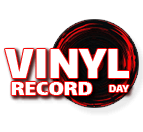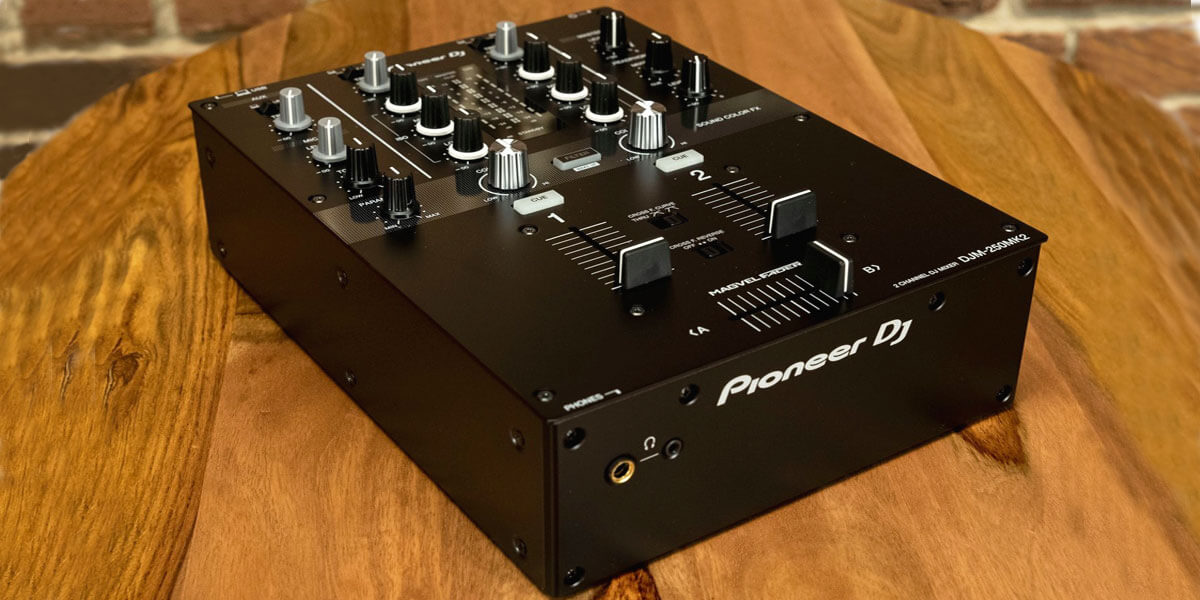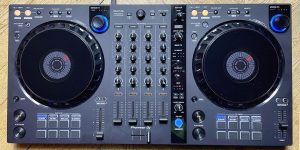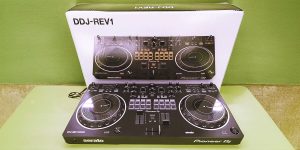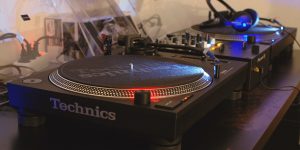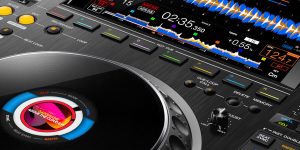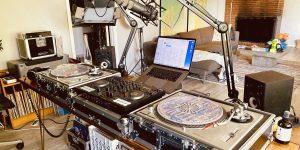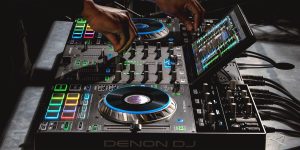I remember starting my journey into the world of disc jockeying, overwhelmed by the sheer number of various audio equipment. The best DJ mixers for beginners were an elusive bunch, hidden amongst an array of intimidating professional-grade units. But don’t fret! With the right guidance, you’ll be mixing and scratching like a pro in no time.
This article serves as a beacon, guiding budding DJs towards user-friendly, feature-packed, and durable mixers that are perfect for those just stepping onto the stage of DJing. The right mixer can transform your novice skillset into a killer set in the blink of an eye. Stick with me, and let’s embark on this exciting journey together.
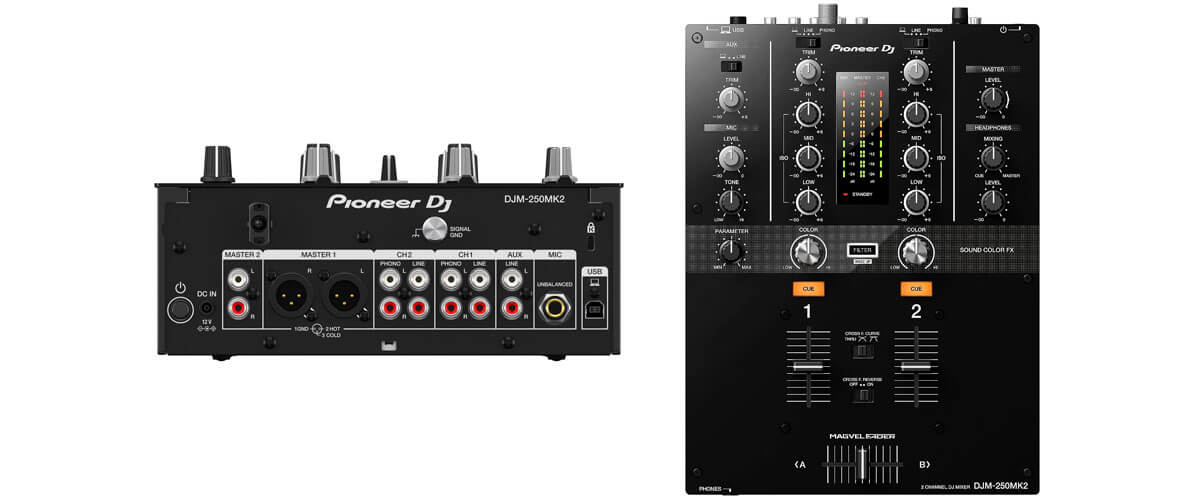
Pioneer DJ mixer for beginners comparison table
| Name | Audio | Inputs | Outputs | USB | Review |
|---|---|---|---|---|---|
| Pioneer DJ DJM-250MK2 best overall | 24-bit, 48kHz | 1 microphone 1/4(6.35mm) TS, 3 line(RCA), 2 microphone(RCA) | 1 RCA stereo pair, 1 XLR, 1 headphone 1/4(6.35mm) TRS, 1 headphone 1/8(3.5mm) TRS | yes | Review |
| Allen & Heath XONE:23 also great | 24-bit, 48kHz | 1 phono(RCA), 1 line(RCA), 1 FX RTN(RCA), 1 microphone(XLR) | 1 XLR, 1 headphone 1/4(6.35mm) TRS, Main Mix Balanced(XLR), Monitor(RCA), Record(RCA), FX SND(RCA) | yes | Review |
| Numark M2 budget | 24-bit, 48kHz | 1 microphone 1/4(6.35mm) TS, 2 line(RCA), 2 phono/line switchable(RCA) | 1 master(RCA), 1 record(RCA), 1 headphone 1/4(6.35mm) stereo | yes | Review |
| Reloop RMX-10 BT with Bluetooth | N/A | 1 microphone 1/4(6.35mm) TS, 2 line(RCA), 2 phono(RCA) | 1 master(RCA), 1 rec(RCA), 1 headphone1/4(6.35mm) jack | yes | Review |
Best DJ mixer for beginners reviews
Pioneer DJ DJM-250MK2 – best overall

Looking for the best value DJ mixer on the market? Well, look no further. Pioneer DJ DJM-250MK2 might be beginner-friendly, but don’t let that fool you – it’s packed with professional-grade features.
Fresh out of the box, the DJM-250MK2 impresses with a clear layout, making even the most complicated scratch techniques a breeze. Take it from me, this mixer has put to the test those robust Magvel faders, and they are the real deal. Smooth control is an understatement, and they are built to endure a DJ’s million-movement marathon.
But the DJM-250MK2 is not just about durability, its smooth mixing is like butter on hot toast. The 3-band isolators offer precision across the highs, mids, and lows. Crank the knob all the way to the left, and you can totally eliminate each frequency range. I’ve tested it, and boy, it adds a new depth to the transitions and allows you to shape your set in ways you never imagined.
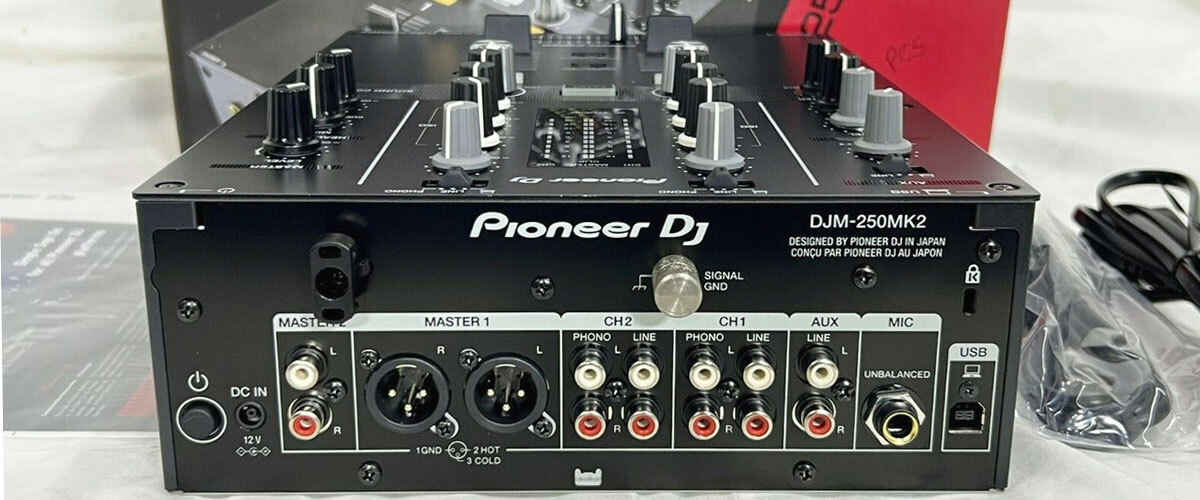
The cherry on top is each channel’s dedicated Sound Color FX filter, a delightful treat inherited from the high-end DJM-900NXS2 mixer. Turn the knob, play around with resonance and tension, and you’ll find your tracks having a new texture, a vibe that is uniquely you.
You might ask, “How does it compare with Allen & Heath XONE:23?” Well, the XONE:23 is indeed a worthy contender, but the DJM-250MK2’s built-in USB sound card and DVS control pull it ahead. Imagine recording your mixes to your computer’s hard drive or smoothly scratching with Rekordbox’s low-latency control. That’s what you get with the DJM-250MK2, no need for an upgrade.
Pioneer DJ DJM-250MK2 doesn’t just tick the boxes for a beginner DJ mixer – it blows them out of the water. So, if you’re a DJ seeking the best DJ mixer for beginners with an eye for value, your search ends here. The DJM-250MK2 is a mixer that grows with you, from your first beat match to your first club gig.
Key specs
- Audio: 24-bit, 48kHz.
- Inputs: 1 microphone 1/4(6.35mm) TS, 3 line(RCA), 2 microphone(RCA).
- Outputs: 1 RCA stereo pair, 1 XLR, 1 headphone 1/4(6.35mm) TRS, 1 headphone 1/8(3.5mm) TRS.
- USB: yes.
- Weight, lbs/kg: 8.7/3.9.
- Mac system requirements: macOS Big Sur 11 (Intel Core Processor/Apple M1 chip), macOS Monterey 12 (Intel Core Processor/Apple M1, M1 Pro, M1 Max, M2 chip), macOS Ventura 13 (Intel Core Processor/Apple M1, M1 Pro, M1 Max, M2 chip).
- PC system requirements: Windows 10, 11(latest service pack).
Pros
- Solid construction and performance.
- Simple, easy-to-use design.
- Suitable for both home use and professional gigs.
- Comes with a Rekordbox DJ and DVS license.
Cons
- The input faders may feel a bit stiff.
- Lack of a Booth/Monitor output.
Allen & Heath XONE:23 – also great
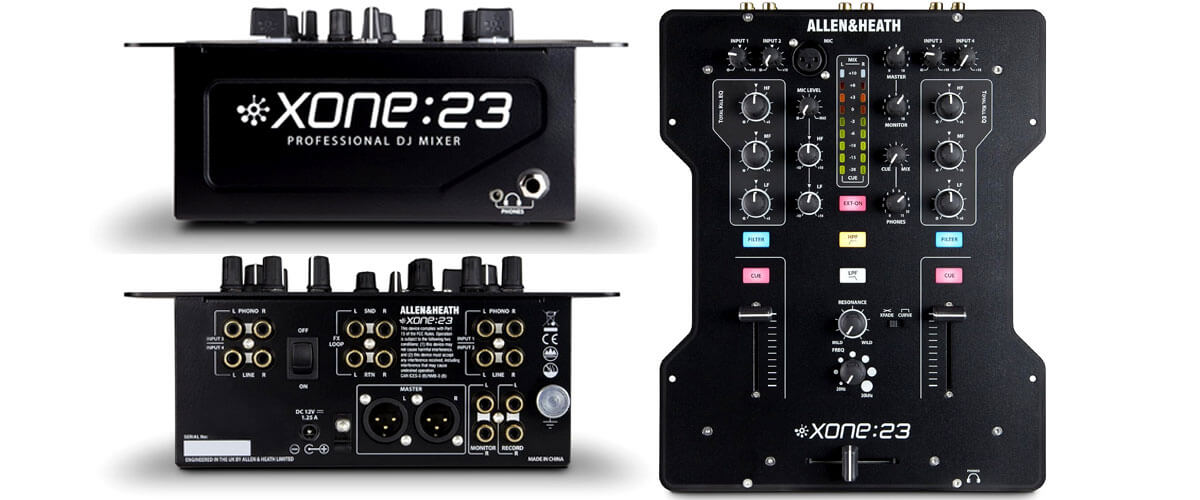
If you’re an aspiring DJ eager to get your hands on a mixer that is truly designed with novice DJs in mind, then Allen & Heath XONE:23 has your name written all over it.
The layout of this model is intuitive and inviting, boasting 2+2 channels with dual phono/line inputs, a setup that effortlessly accommodates a variety of audio sources. During my testing, every mix was a crystal-clear symphony, each track reborn with a vibrant depth that elevates your performance.
But where this mixer truly excels is in the realm of sound sculpting, offering tools even the Pioneer DJ DJM-250MK2 can’t match. The VCF filter system, with its low and high pass filters coupled with resonance controls, opens up a whole new world of creative expression. Picture yourself tweaking a track, amplifying a pulsing bassline, or spotlighting a sizzling hi-hat with surgical precision – the XONE:23 hands you the keys to this level of control.
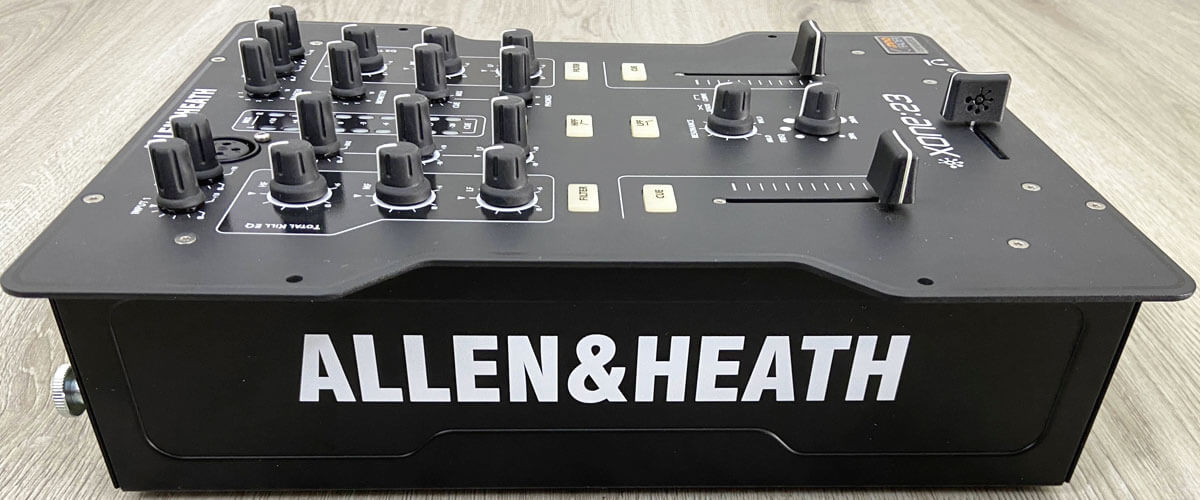
An absolute favorite is the 3-band total kill EQ, a feature that gives you the power to obliterate specific frequencies and redefine your soundscape. Add to this the external FX loop, and you have a platform for injecting your preferred effects and truly personalizing your mixes.
While the XONE:23 may lack the built-in USB interface of its Pioneer counterpart, I wouldn’t let that sway you. This beauty is about honing the craft of mixing, not drowning in digital overload.
So, in the hunt for a perfect DJ mixer board for beginners, don’t overlook the Allen & Heath XONE:23. It’s not just a mixer, it’s the starting point of a journey into the art of DJing, one that encourages you to explore, learn, and create your unique sound.
Key specs
- Audio: 24-bit, 48kHz.
- Inputs: 1 phono(RCA), 1 line(RCA), 1 FX RTN(RCA), 1 microphone(XLR).
- Outputs: 1 XLR, 1 headphone 1/4(6.35mm) TRS, Main Mix Balanced(XLR), Monitor(RCA), Record(RCA), FX SND(RCA).
- USB: yes.
- Weight, lbs/kg: 6/2.7.
- Mac system requirements: Mac OS X 10.12 Sierra, Mac OS X 10.13 High Sierra, Intel Core i3/1.07 GHz, RAM 4GB.
- PC system requirements: Windows 10, 11(latest service pack).
Pros
- Small unit with high-quality standards.
- Versatile with its 2+2 channels, VCF filter system, and 3-band true total kill EQ.
- Provides robust audio control.
- Great for beginners interested in live performances.
Cons
- Lacks advanced digital features.
- Phono inputs might be a bit quiet.
Numark M2 – budget
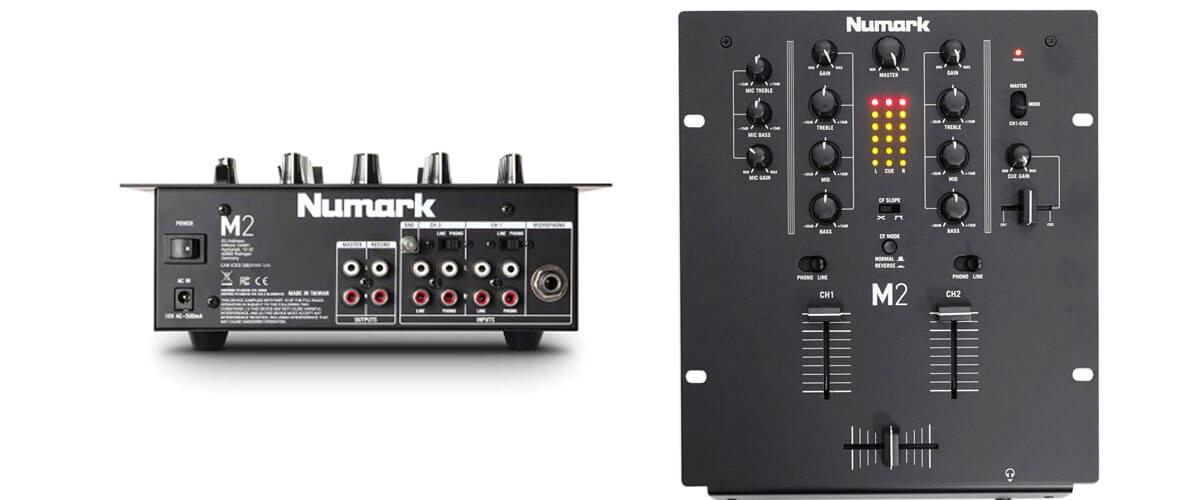
An entry-level DJ stepping into the booth might feel overwhelmed by all the flashy gear out there. That’s where Numark M2 comes in. This deck is a perfect companion for those just starting to navigate the electrifying landscape of DJing.
The M2 is a basic DJ mixer in its purest form. Yet, its simplicity is what makes it stand out. The mixer’s stripped-down, no-frills design eliminates the chaos and lets you focus on the essence of mixing.
The beauty of this model lies in its versatility. It offers phono and line switchable inputs and dedicated mic and headphone outputs. The result? A setup that fits every DJing scenario, from house parties to club nights. The replaceable crossfader and channel-level faders provide a responsive feel, allowing precise control over each transition. I’ve personally mixed tracks on the M2 and found it incredibly intuitive, great for honing your beat-matching skills.
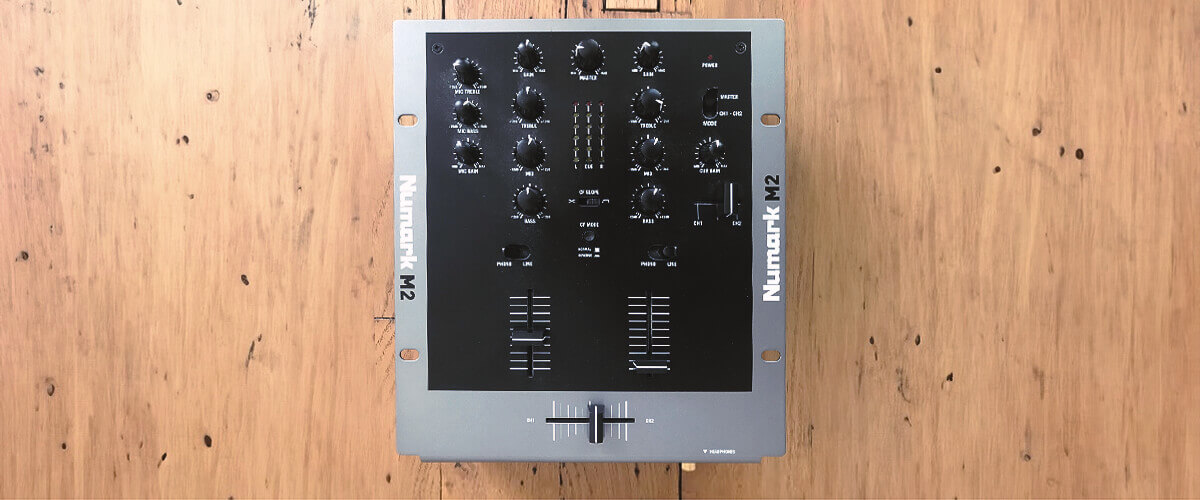
One limitation, however, is the absence of built-in effects. A handy workaround here is to integrate an external FX processor into your setup, expanding your sonic palette and adding a personal touch to your sets.
The M2’s three-band EQs and crossfader style cueing further enhance the mixing experience. And let’s not forget the sleek, ultra-portable design with a style that’s made to move.
Numark M2 stands as a strong contender for the best-budget beginner mixer. It offers an accessible, fun, and educational platform for emerging DJs to learn and perfect their mixing craft. With this console, you can hit the ground running and start your DJ journey on the right beat.
Key specs
- Audio: 24-bit, 48kHz.
- Inputs: 1 microphone 1/4(6.35mm) TS, 2 line(RCA), 2 phono/line switchable(RCA).
- Outputs: 1 master(RCA), 1 record(RCA), 1 headphone 1/4(6.35mm) stereo.
- USB: yes.
- Weight, lbs/kg: 8.8/3.9.
- Mac system requirements: Mac OS X 10.12 Sierra, Mac OS X 10.13 High Sierra, Intel Core i3/1.07 GHz, RAM 4GB.
- PC system requirements: Windows 10, 11(latest service pack).
Pros
- Budget-friendly yet feature-packed option.
- Compatible with a variety of audio sources and entertainment systems.
- Noticeable volume levels without distortion.
- Compact design, doesn’t take up much space.
Cons
- Doesn’t have an independent microphone on/off switch.
- The sliders for channels 1 & 2 and the crossfade seem to move too easily.
- Some users reported inconsistent volume levels on the fader, particularly when scratching.
Reloop RMX-10 BT – with Bluetooth
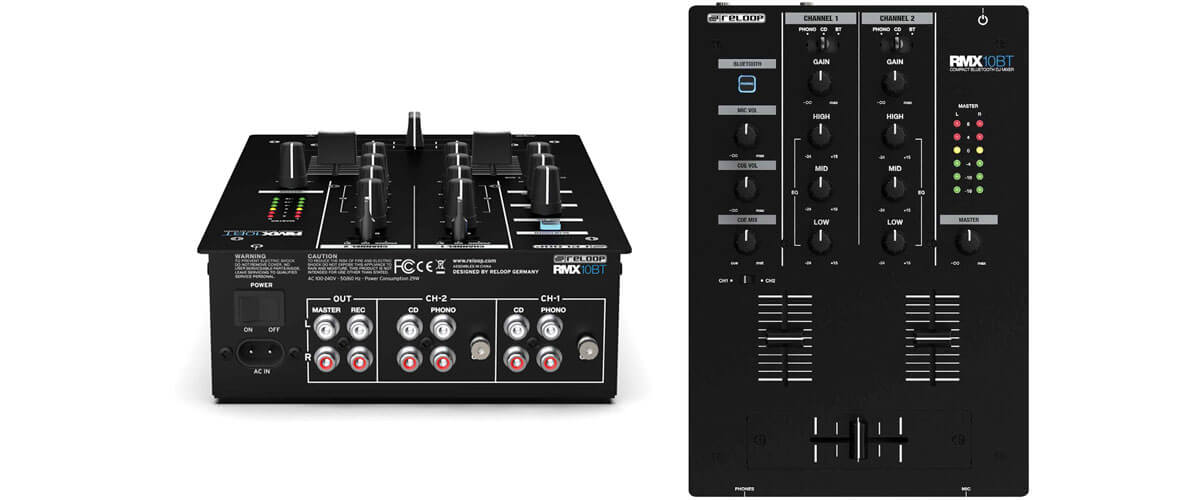
If you’re in the market for an ideal Bluetooth-enabled DJ mixer for beginners, you’ll want to turn your attention to the Reloop RMX-10 BT.
This model stands out for its integrated Bluetooth connectivity, which I found to be an absolute game-changer during my tests. It allows for seamless streaming of tracks directly from your smartphone or tablet, taking the hassle out of preparing a set. This feature makes the RMX-10 BT perfect for impromptu sessions or adding that surprise track to your mix.
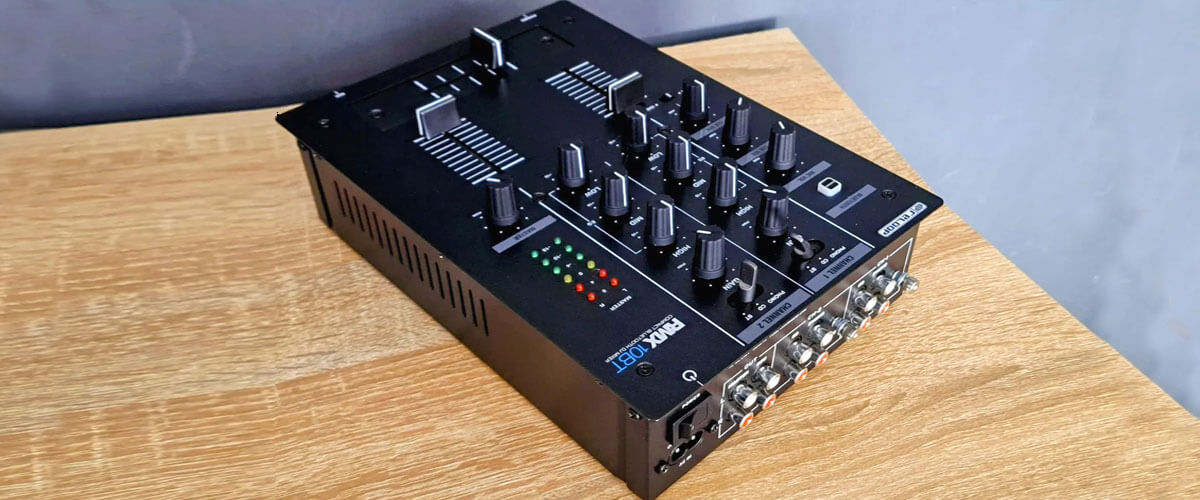
Each channel strip on the mixer features a 3-band EQ and gain adjustment, giving you total control over your sound. Furthermore, the replaceable 45 mm crossfader and line faders enable smooth transitions, and the mic input with dedicated volume control is a nice touch.
Reloop RMX-10 BT’s compact size, versatility, and ease of use make it a good beginner DJ mixer. If you’re a newcomer to the DJ scene and want to experiment without breaking the bank, it offers a solid foundation to start your mixing journey.
Key specs
- Audio: N/A.
- Inputs: 1 microphone 1/4(6.35mm) TS, 2 line(RCA), 2 phono(RCA).
- Outputs: 1 master(RCA), 1 rec(RCA), 1 headphone1/4(6.35mm) jack.
- USB: yes.
- Weight, lbs/kg: 2.2/1.7.
- Mac system requirements: Mac OS X 10.12 Sierra, Mac OS X 10.13 High Sierra, Intel Core i3/1.07 GHz, RAM 4GB.
- PC system requirements: Windows 10, 11 (latest service pack).
Pros
- Compact and robust all-metal construction.
- Solid grounding lugs, which help to ensure a quiet operation.
- Lightweight crossfader suitable for scratching and lightweight faders that allow micro controls on the volume of the tracks during the mix.
- Suitable for old-style management of the mix with both turntables and CDJs.
- The good sound quality on both phono and line-in with precise equalization controls.
Cons
- LED volume markers do not give a signal until the volume is at its maximum.
- The Bluetooth functionality has a limited range – connection is lost over one meter.
Numark M6 USB
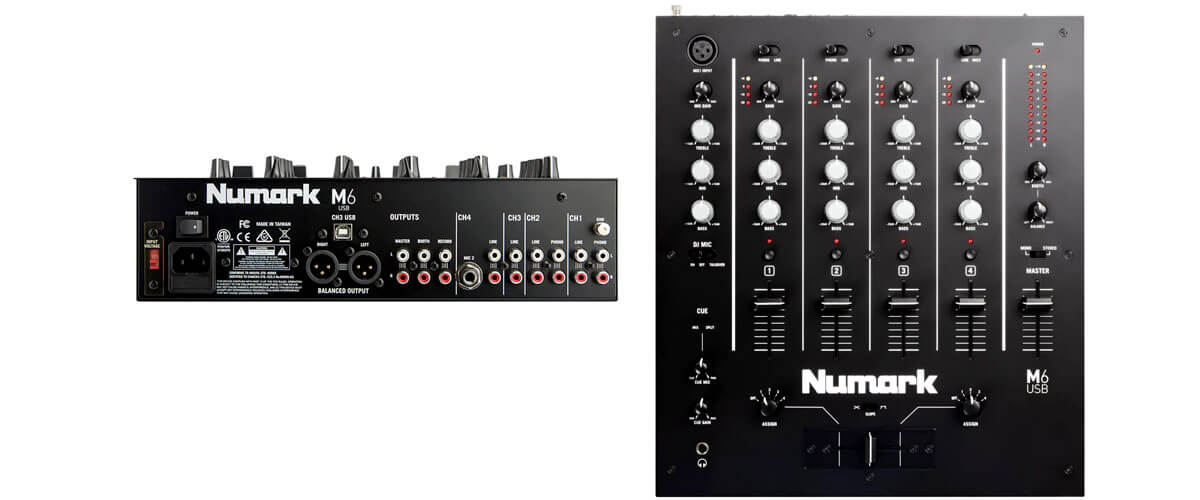
Numark M6 USB, with its four channels, empowers you to weave a sonic tapestry from various music sources, broadening your creative horizons.
What strikes me about this model is its extensive connectivity. Whether spinning vinyl or delivering a heart-thumping EDM set from your laptop, it has you covered. You’ve got multiple phono, line, and mic inputs, plus outputs for master, record, booth, and headphones.
Furthermore, you have the tools to mix with precision thanks to the replaceable crossfader and dedicated channel-level faders. Seamless transitions or well-timed beat drops, the M6 USB handles it all. To top it off, each channel comes with a three-band EQ for granular sonic shaping.
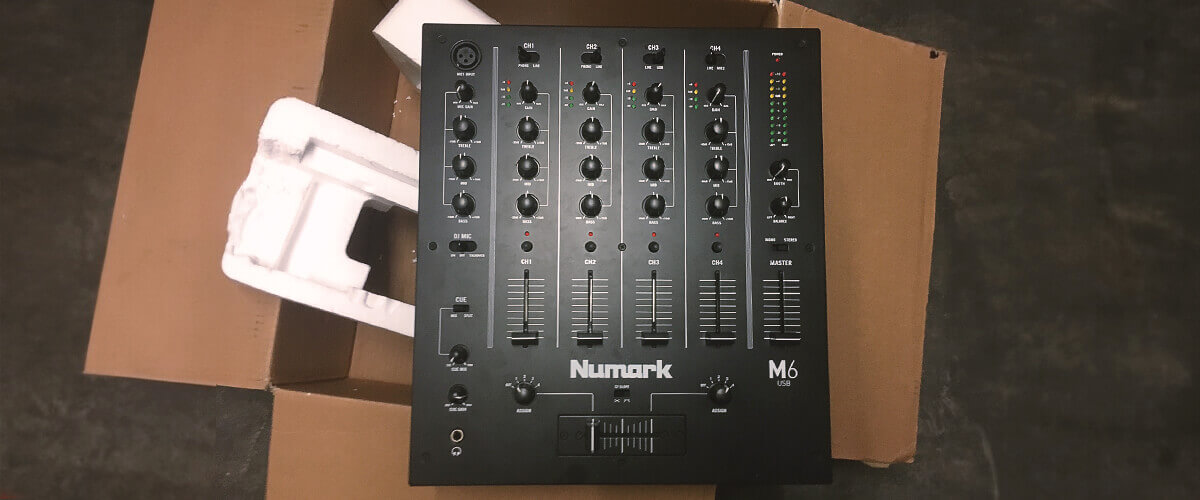
This model also boasts a USB connection for seamless plug-and-play with your Mac or PC. Plus, its sleek, ultra-portable design with radiant LED monitoring adds a visual flourish to your performance.
Comparatively, the Native Instruments Traktor Kontrol Z1, though equipped with a soundcard and included software, can’t quite match the M6 USB’s flexibility. The Z1 is an excellent piece of kit, but its connectivity options are more limited.
In conclusion, Numark M6 USB is a great DJ mixing table for beginners that offers versatility and control at a price that won’t break the bank. An excellent choice for novice DJs who want a little more from their setup.
Key specs
- Audio: 24-bit, 48kHz.
- Inputs: 2 microphone 1/4(6.35mm), 1 line(RCA), 1 phono(RCA).
- Outputs: 1 master(RCA), 1 master(BALANCED XLR), 1 record(RCA), 1 booth(RCA).
- USB: yes.
- Weight, lbs/kg: 9/4.
- Mac system requirements: Mac OS X 10.12 Sierra, Mac OS X 10.13 High Sierra, Intel Core i3/1.07 GHz, RAM 4GB.
- PC system requirements: Windows 10, 11 (latest service pack).
Pros
- Sturdy, all-metal construction.
- Versatile – can be used for DJing, home entertainment systems, video audio mixing, and voiceovers.
- Buttery smooth faders that are easy to modulate.
- Good feedback from knobs.
- Easy setup and immediate recognition by Serato DJ Pro.
Cons
- Requires unbalanced mic cable.
- The microphone line in may be quiet, even when maxed out.
- Some users reported inconsistent volume levels on the fader.
Native Instruments Traktor Kontrol Z1
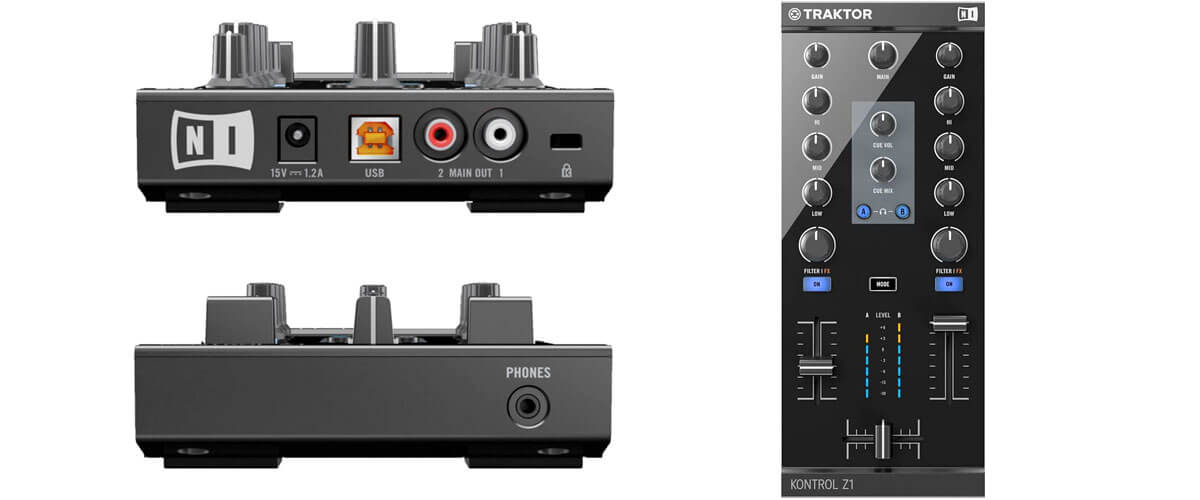
Stripped down to the essentials but punching above its weight, the Native Instruments Traktor Kontrol Z1 sets the bar for simplicity in DJ mixers.
Don’t be fooled by its compact form – the Z1 serves up a pro-grade audio experience with its great 24-bit sound card. Whether a high-energy EDM track or a laid-back lo-fi beat, this mixer delivers crystal clear audio that keeps the dancefloor moving.
This model’s layout is all about effortless control. It comes with a dedicated mixer featuring a 3-band EQ, gain, filter, and pre-listen controls for each channel. The power is literally at your fingertips!

Unlike the Numark M6 USB, the Z1 may not have a bevy of input/output options. Yet, its focus on the essentials is what makes it shine. If you find the lack of physical connectivity limiting, using the included Traktor LE software can bridge this gap. This integration lets you craft your sound digitally while maintaining the feel of an authentic DJing experience.
Traktor Kontrol Z1 strikes a harmonious balance of ease of use and versatility, offering a refreshingly simple DJ mixer that brims with potential. So, if you’re eager to embark on your DJing journey, this could be the ideal companion to unlock your creativity.
Key specs
- Audio: 24-bit, 96kHz.
- Inputs: N/A.
- Outputs: 2 main(RCA).
- USB: yes.
- Weight, lbs/kg: 1.4/0.6.
- Mac system requirements: macOS 11, 12, 13 (latest update), iTunes 12 (latest update), Intel Core i5 or Apple M1/M2, 4 GB RAM.
- PC system requirements: Windows 10, 11 (latest service pack), Intel Core i5 or equivalent CPU, 4 GB RAM.
Pros
- Rubberized knobs – sturdy build and soft to the touch.
- The Line faders are smooth and not too loose.
- Works well with the Traktor DJ app for iPad, providing more precise control over levels, gains, highs, mids, lows, fx that need finesse.
- Portable – perfect for mobile gigs or DJing at small parties.
Cons
- The deck plate is very prone to smudging and surface scratches.
- A minor annoyance in the filter feature, where the filter sound changes values momentarily, even in a neutral position.
- The provided cables are a bit cumbersome and may require adapters to work with certain devices.
Essential DJ mixer features for beginners
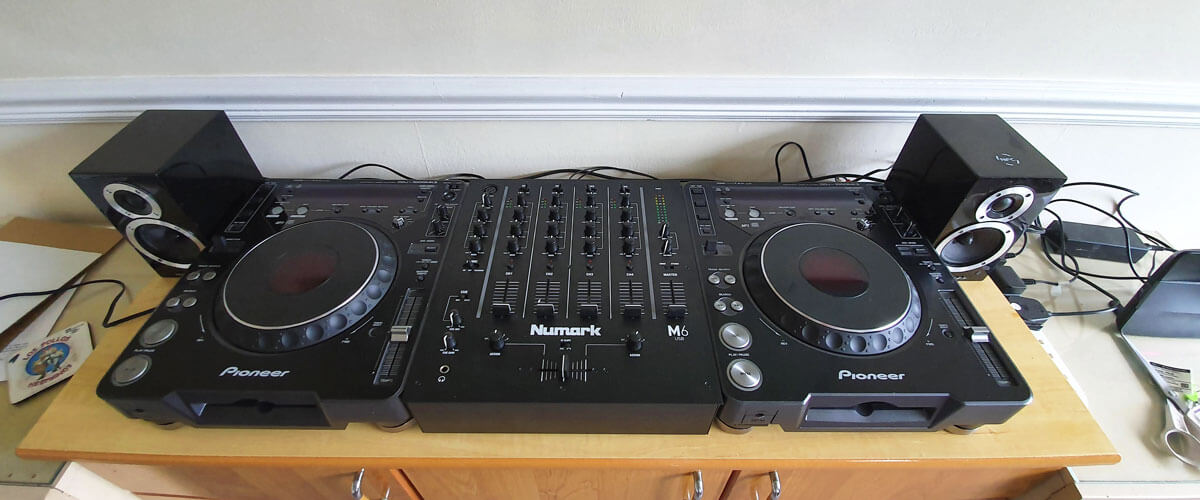
As you enhance your mixing skills, knowing the essential features of DJ mixers is important. Let’s dive into the core elements that can elevate your beginner DJ game to new heights.
User-friendliness
For a beginner, the overall design of a DJ mixer is a make-or-break factor. An intuitive layout with easily identifiable controls is key. The quicker you can navigate your mixer, the smoother your learning curve. User-friendly designs allow you to focus more on crafting your sound rather than wrestling with complex controls.
Number of channels
When choosing a starter DJ mixer, consider the number of channels. Each channel corresponds to a different sound source, allowing you to blend multiple tracks simultaneously. Starting with a two-channel mixer is common for novices, offering enough versatility for basic mixing. However, opting for more channels can provide room for growth, enabling you to experiment and expand your DJing prowess as you gain confidence and skill.
EQ controls
EQ controls are the heart and soul of a DJ mixer, granting you the power to shape the sound’s frequency components – the bass, mid-range, and treble. Proper equalization is key in creating smooth transitions and blending tracks harmoniously. A quality mixer should have clear and responsive EQ knobs or faders. These controls let you add your unique touch to the music, whether amplifying the bass to get the crowd moving or tweaking the treble for a crisp, bright effect. Mastering the art of equalization can truly set your mixes apart.
Built-in effects
Beyond the fundamentals, some mixers offer a bit of extra spice – built-in sound effects. These can range from reverb and delay to phaser and more. While these effects aren’t a strict necessity for beginners, they certainly add an exciting layer of creative potential to your mixes. You can use them to create unique sonic textures or add drama and excitement at just the right moments. As you begin to experiment with these effects, you’ll not only have a ton of fun but also learn more about the intricate art of sound manipulation.
Interface and connectivity
Your DJ mixer should be a social creature, easily connecting to a range of devices. Look for boards with USB ports for seamless computer connection, facilitating digital mixing or recording sessions. RCA jacks are vital for hooking up turntables or CDJs, and XLR outputs ensure compatibility with professional sound systems. Don’t forget about the humble headphone jack – a vital feature for pre-listening to tracks and perfecting those smooth transitions. The more versatile the connectivity, the more freedom you’ll have to tailor your setup to your specific needs and preferences.
Identify your specific needs
One size certainly doesn’t fit all when it comes to the perfect music mixer for beginners. Identifying your specific needs is essential. Ask yourself – are you just mixing for fun at home, or do you aspire to rock parties and events? Are you enchanted by the tactile feel of vinyl, or do you prefer the endless possibilities of digital software platforms? Perhaps you’re drawn to the versatility of using both? Knowing your goals and preferences will guide you toward the mixer that’s the perfect fit for your DJing journey.
Look for quality and durability
A DJ mixer isn’t just a purchase, it’s an investment. As a piece of equipment destined for heavy use, it should be built to weather the storm of your DJing endeavors. It’s worthwhile researching the build quality and hunting for a unit that combines robust construction with smooth, durable controls. Don’t overlook user reviews either – they can provide valuable insights into the mixer’s long-term performance and reliability. By choosing a device that’s built to last, you’ll ensure your DJ journey isn’t cut short by a premature hardware breakdown.
